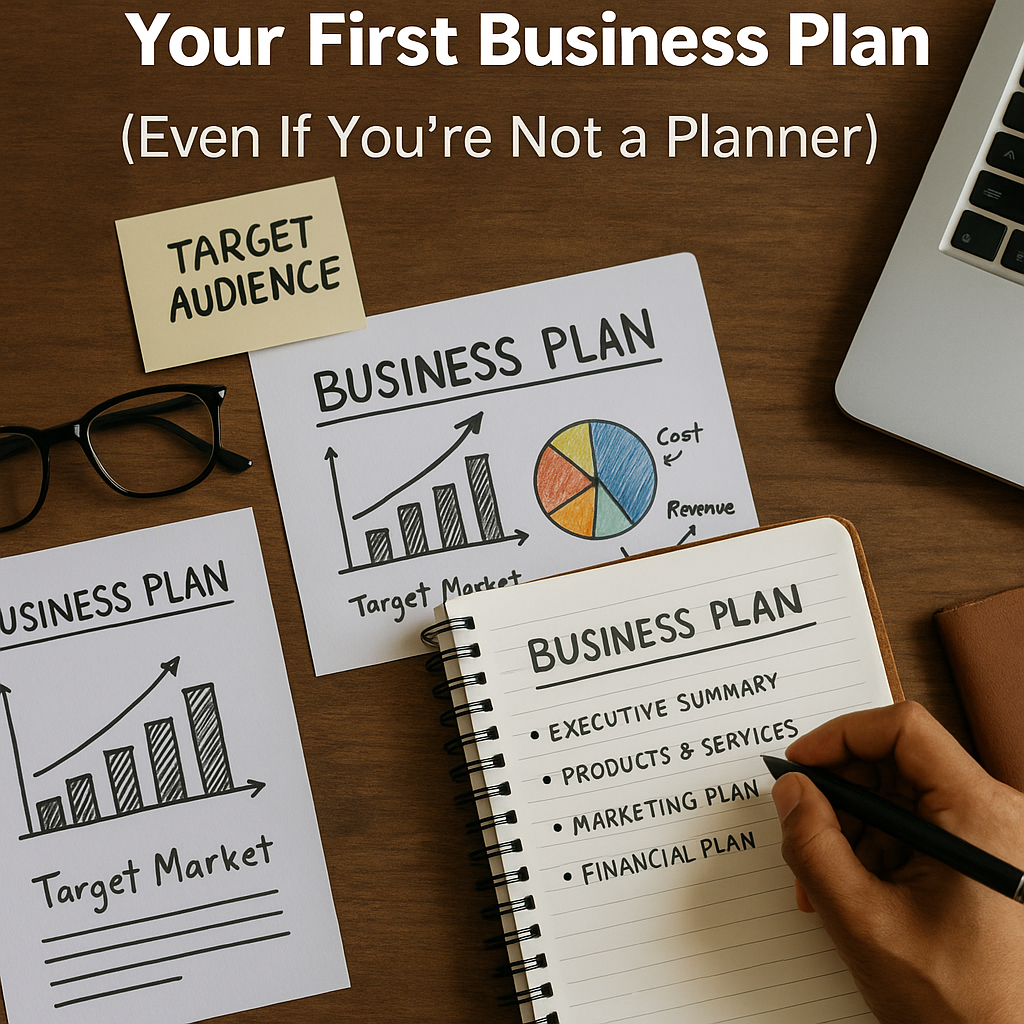If you’re a first-time entrepreneur, you might feel overwhelmed by the idea of writing a business plan. Maybe you’re not a “planner” or you’re more of a doer. That’s okay!
The truth is, your first business plan doesn’t need to be perfect—it just needs to give you clarity. A simple, well-structured plan helps you make smart decisions, avoid confusion, and move forward with purpose.
Let’s walk through how to create a basic business plan, even if you’re starting from scratch.
Why Do You Need a Business Plan?
A business plan helps you:
- Stay focused and organized
- Set realistic goals
- Understand your audience
- Attract partners or investors
- Clarify how you’ll make money
- Avoid costly mistakes
Think of it as your roadmap—a document that helps guide your next steps.
What to Include in a Simple Business Plan
You don’t need 50 pages. You can create a powerful plan in just 1 to 5 pages using these sections:
1. Executive Summary (1–2 paragraphs)
This is your elevator pitch.
- What does your business do?
- Who do you serve?
- What makes your idea unique?
- What is your short-term and long-term goal?
Example:
“BoldBrew is a small-batch coffee subscription service for remote workers who want high-energy, sustainably sourced coffee. We aim to grow from 100 to 1,000 subscribers within the first year.”
2. Problem and Solution
Explain the problem your audience faces and how you solve it.
- What pain point are they experiencing?
- How is your product or service the answer?
Example:
Remote workers often feel drained and distracted. Our coffee blends are designed to boost focus and energy without the crash.
3. Target Market
Define who you’re serving.
Include details like:
- Age range
- Occupation
- Location
- Pain points
- Behaviors (where they hang out, what they value)
Example:
Our ideal client is a 25–40-year-old remote professional who values productivity, wellness, and artisan experiences.
4. Product or Service Details
Describe what you’re selling.
Include:
- Features and benefits
- Price points
- What makes it different from competitors
- Future versions or upgrades (if any)
Example:
We offer monthly and quarterly coffee subscriptions with unique blends. Each order includes a productivity tip card.
5. Marketing Strategy
How will you reach your audience?
Include:
- Social media platforms
- Content strategy (reels, blogs, podcasts)
- Email marketing
- Referral programs
- Paid ads (if any)
Example:
We’ll focus on Instagram Reels, influencer collaborations, and a free productivity guide to build our email list.
6. Business Model
How will you make money?
Explain your:
- Revenue streams
- Pricing structure
- Upsell or cross-sell opportunities
- Potential partnerships
Example:
Monthly subscription: $29/month. We’ll upsell premium accessories like mugs, kettles, and limited-edition blends.
7. Financial Projections
No need to be a finance expert. Just outline the basics:
- How much do you expect to spend monthly?
- How much revenue do you need to break even?
- What’s your income goal for the next 6–12 months?
Tip: Use a simple spreadsheet to track projected income vs. expenses.
8. Team and Tools
List who’s helping you (even if it’s just you for now):
- Co-founders
- Freelancers or consultants
- Tools you’ll use (like Canva, Shopify, Notion, etc.)
9. Timeline and Milestones
Set a realistic roadmap for the next 3, 6, and 12 months.
Example:
- Month 1: Build landing page and lead magnet
- Month 2–3: Get 100 email subscribers
- Month 4: Launch paid subscriptions
- Month 6: Break even on monthly costs
Milestones help you track progress and celebrate small wins.
10. Optional: Vision Statement
Where do you see this business in 3–5 years?
This doesn’t need to be perfect—just a bold direction.
Example:
“In five years, we want BoldBrew to be the go-to brand for energized remote teams, with over 10,000 global subscribers.”
Tools to Help You Build Your Business Plan
- Canva Docs or Google Docs – clean layout and templates
- Notion – great for dynamic, editable planning
- LivePlan – business plan software (paid)
- Trello – organize milestones visually
- ChatGPT 😉 – to brainstorm or edit your drafts
Final Thoughts: Start Simple, Adjust as You Grow
You don’t need to wait to “feel ready” to write your first business plan. Start small, stay flexible, and treat it like a living document you can update as your business evolves.
The most important thing is that you understand where you’re going and why.
Write it, print it, refer to it—and then go make it happen.
